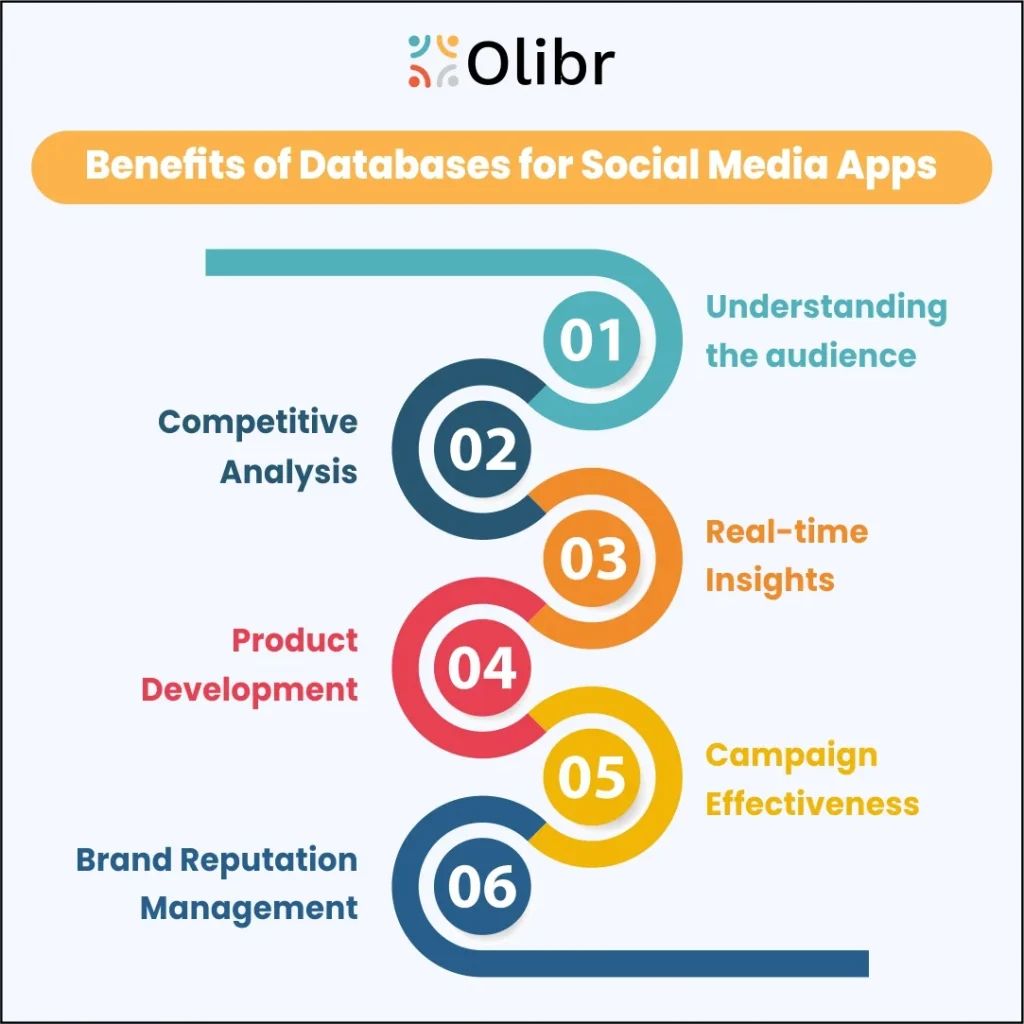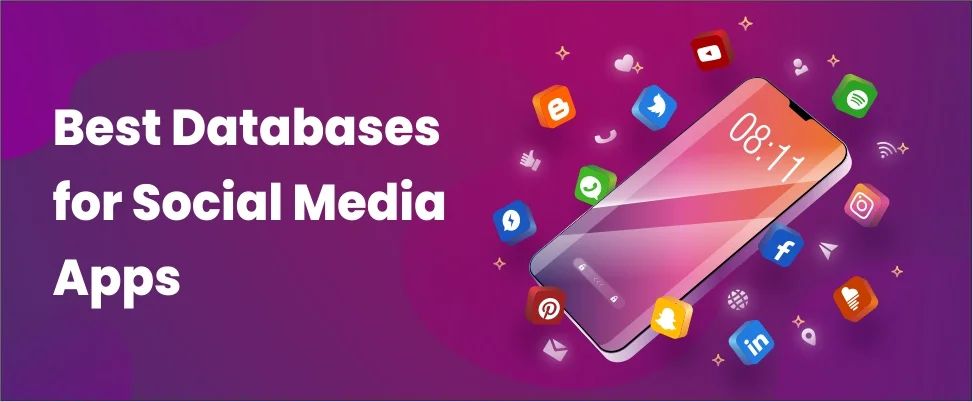Table of Contents
ToggleIntroduction
The revolution of social media and mobile phone technology has dramatically increased social media content and apps. Today users are spoilt for choice with Facebook, Instagram, TikTok, X, and other social media apps. But what is more interesting from a developer’s perspective is the tech stack of these apps. In this blog, we will look at the databases that keep them up and running.
Why Do Social Media Apps Use Databases?
Social media platforms are powerful tools that keep individuals and businesses connected. Billions use different media apps such as Facebook, Instagram, LinkedIn, TikTok, and more to share their thoughts and preferences. Naturally, these apps have large volumes of data to be gathered, stored, retrieved, analyzed and managed seamlessly. The one-word answer to this is Database. Social media apps require robust databases to store information, enable interactions between users, analyze and distribute content, and make recommendations.
Must Read: WHAT ARE THE VARIOUS TYPES OF DATABASES? Top Reasons Why Social Media Apps Use Databases

Understanding the audience
Social media platforms survive on predicting and understanding their users. Databases help social media apps gain deep insights into their users. They analyze user interests, online behaviors, and demographic information to customize UI/UX and marketing strategies.
Competitive Analysis
The Social Media market is fiercely competitive. Databases allow social media apps to monitor competitor behavior. This information can be used to identify the strengths and weaknesses of competitors, discover new trends, and develop strategies.
Real-time Insights
Social media platforms need real-time data analyses so that they can survive in the fast-paced digital world. Databases offer up-to-the-minute data, which allows social media companies to respond to emerging trends or crises.
Product Development
Many businesses host their products and services on social media. For social media apps that host businesses, customer feedback can help them hit the jackpot for product development. Databases allow social media apps to analyze user comments and suggestions. This helps businesses running via social media make informed decisions about product improvements and innovations.
Campaign Effectiveness
Social Media marketing teams leverage databases to optimize their marketing efforts. Analytics databases help evaluate the success of social media campaigns through analytics databases. Databases use metrics such as click-through rates, engagement rates, and conversion rates to offer valuable feedback.
Brand Reputation Management
Social media databases help allow social media companies to monitor mentions of their brand in real-time. This helps address negative sentiments that may harm a brand.

Don't miss out on your chance to work with the best
apply for top global job opportunities today!
The Best Databases for Social Media Apps
Graph Databases
Graph databases are NoSQL databases that use graph structures for creating and manipulating graphs. They are designed to handle complex relationships between data entities. Graph databases help in modeling social networks, where connections between users, posts, comments, and other entities are crucial.
Top Graph Databases
Neo4j: With a flexible data model and powerful query language called Cypher, Neo4j is optimized for graph traversal and analysis. It helps social media apps represent complex relationships between users, content, and interactions. This helps with efficient recommendation systems, fraud detection, and network analysis.
Amazon Neptune: It helps social media applications with social graphs and interest networks, with low latency and high availability. Amazon Neptune supports property graph and RDF graph models, and integration with other AWS services.
GraphBase: It helps social media apps store user connections, content relationships, and behavioral patterns. As a result, this facilitates personalized content recommendations and social network analysis.
ArangoDB: Social media platforms can use ArangoDB to model complex relationships, user interactions, and content hierarchies. The database also helps store related metadata as documents.
DataStax: It allows social media apps to manage highly connected data, such as user networks, content relationships, and event streams, with distributed scalability and fault tolerance.
Document Databases
Also known as a document-oriented database or a document store, a document database stores information in documents. Social media data such as user profiles, posts, comments, and other content is usually stored in document databases. They store content in a flexible and schema-less format and allow for easy nesting of related data and support rich queries.
Top Document Databases
Amazon DynamoDB: Social media applications can leverage DynamoDB to store and retrieve flexible JSON documents of user profiles, posts, comments, and other content. DynamoDB’s scalability, low latency, and seamless integration with other AWS services help build real-time and globally distributed social media platforms.
MongoDB: Social media apps can use MongoDB to store dynamic and evolving data structures, such as user profiles, conversations, and multimedia content. The database has rich query language, horizontal scalability, and automatic sharding. These features allow developers to build responsive and highly available social media platforms.
MongoDB Atlas: Atlas’s automated deployment, scaling, and backup features allow database developers to focus on building their applications without worrying about infrastructure management. The global clusters and built-in security features of MongoDB Atlas ensure data availability, reliability, and compliance for social media platforms operating at scale.
Google Cloud Firestore: It supports real-time data synchronization and offline data persistence. This is ideal for social media apps that require responsive and collaborative user experiences.
MarkLogic: Social media platforms can leverage MarkLogic’s document capabilities to store and manage rich media content, user-generated data, and metadata efficiently. It offers ACID transactions, full-text search, and flexible indexing. This makes MarkLogic a great choice for building scalable social media applications with stringent performance and compliance requirements.
Also Read: TOP 10 DATABASE MANAGEMENT SYSTEMS IN 2024 Key-Value Stores
Key-value databases are designed to store, retrieve, and manage associative arrays and dictionaries. Also known as key-value stores, these databases are ideal for handling real-time notifications, storing user sessions, and caching frequently accessed data, in social networks. They offer high-performance reads and writes, making them suitable for handling user interactions.
Top Key-Value Databases
Redis: Redis’s key-value data model help social media sites store user sessions, cache frequently accessed data, and implement real-time messaging and notifications. Its support for data structures like strings, lists, sets, and hashes helps build scalable and responsive social media platforms.
Memcached: Social media apps can employ Memcached to cache database queries, user profiles, and frequently accessed content, reducing response times and improving scalability. The database has an efficient key-value interface and support for multi-threaded access. This makes it a great choice for handling high traffic and concurrent user interactions in social media platforms.
Aerospike: Aerospike’s flash-optimized storage and distributed architecture helps store user-generated content, perform real-time analytics, and deliver personalized recommendations. Its strong consistency, automatic sharding, and cross-datacenter replication capabilities ensure high availability and fault tolerance for social media platforms.
Amazon DynamoDB: DynamoDB’s key-value data model allows social media sites to store user profiles, session data, and metadata. Additionally, the database also offers built-in support for automatic scaling, backups, and multi-region replication. Its integration with other AWS services makes DynamoDB a cost-effective and reliable choice for building scalable and responsive social media platforms.
Amazon ElastiCache: ElastiCache helps offload database read operations, improves response times, and enhances overall application performance. It also offers automatic scaling, data persistence, and multi-AZ deployment options. This ensures high availability and durability for caching social media platforms serving millions of users concurrently.
Relational Databases
Relational databases organize social media data into rows and columns. Social media apps use relational databases to store user profiles, posts, interactions, and connections. Relational databases also help social networking sites in managing structured data such as user authentication, permissions, and transactional data.
Top Relational Databases
MySQL: It is widely used in social media applications for storing user profiles, posts, comments, and other data. MySQL’s support for high concurrency and efficient data indexing helps social media sites handle large volumes of user-generated content.
Amazon RDS: Social media apps using Amazon RDS benefit from automated backups, scalability, and high availability features. This allows the developers to focus on application development rather than database management.
PostgreSQL: PostgreSQL is used for storing user interactions, relationships, and analytical data. It also allows full-text search, which makes it suitable for handling diverse data types in social media applications.
MariaDB: MariaDB’s performance optimizations and scalability enhancements help manage user-generated content, messaging, and activity feeds. Moreover, its support for clustering and high availability configurations ensures reliability for mission-critical applications.
Microsoft SQL Server: It has features such as columnstore indexes, in-memory OLTP, and built-in analytics capabilities. SQL Server allows social media apps to analyze user behavior, deliver personalized content, and optimize performance.
Also Read: BEST PROGRAMMING CERTIFICATIONS FOR 2024 Multi-Model Databases
Social media apps benefit a great deal from multi-model databases as they have multiple data models and databases built into a single database. These databases allow you to store data as key/value pairs, graphs, or documents with one declarative query language.
Top Multi-Model Databases
MarkLogic: MarkLogic offers social media apps the flexibility to handle diverse data types such as user profiles, posts, relationships, and metadata. Its search capabilities, ACID transactions, and scalability make it an ideal choice for complex social media platforms with real-time data processing needs.
OrientDB: OrientDB’s graph capabilities represent social network connections while storing user-generated content and metadata as documents. OrientDB’s distributed architecture and support for SQL queries enable efficient data retrieval. Additionally, it also allows analyses within large-scale social media platforms.
Azure Cosmos DB: Cosmos DB supports document, graph, key-value, and column-family data models. With this, store and query diverse types of data with low latency and high availability can be stored across regions. Azure Cosmos offers scalability and comprehensive SLAs for mission-critical social media applications.
FoundationDB: FoundationDB’s offers support for document and key-value data models. This helps manage user-generated content, messaging, and real-time interactions. Moreover, its built-in fault tolerance ensures data consistency and reliability for social media workloads.
Couchbase: Couchbase has a distributed architecture and memory-first design. It is used to store social media user profiles, posts, comments, and activity streams. Further, it supports SQL-like queries, full-text search, and mobile synchronization, which helps build responsive and scalable social media platforms.
Which is the Best Database for Social Media Apps?
As we detailed in the blog, there is no single winner here. Different types of databases offer crucial functionalities that keep social media apps up and running. As a social media database expert, you must choose a combination of databases that ensure scalability, optimal performance, and data management capabilities. With the right database, social media apps can handle massive volumes of user-generated content efficiently, facilitate seamless interactions, and deliver personalized experiences. If you are a developer or a database specialist looking for jobs that match your skill sets, sign up with Olibr to know more.
Take control of your career and land your dream job
sign up with us now and start applying for the best opportunities!

FAQs
NoSQL databases such as MongoDB and Cassandra have horizontal scalability and are a great option for videos.
Relational databases are the most popular as they store related data in tables.
While many databases are free to use, many databases are expensive as they offer premium features. It costs to integrate licensing, training, security features, support, and hosting of the database.
Amazon DynamoDB, Google Cloud Firestore, Amazon DocumentDB, and MongoDB are some databases known for their performance.

